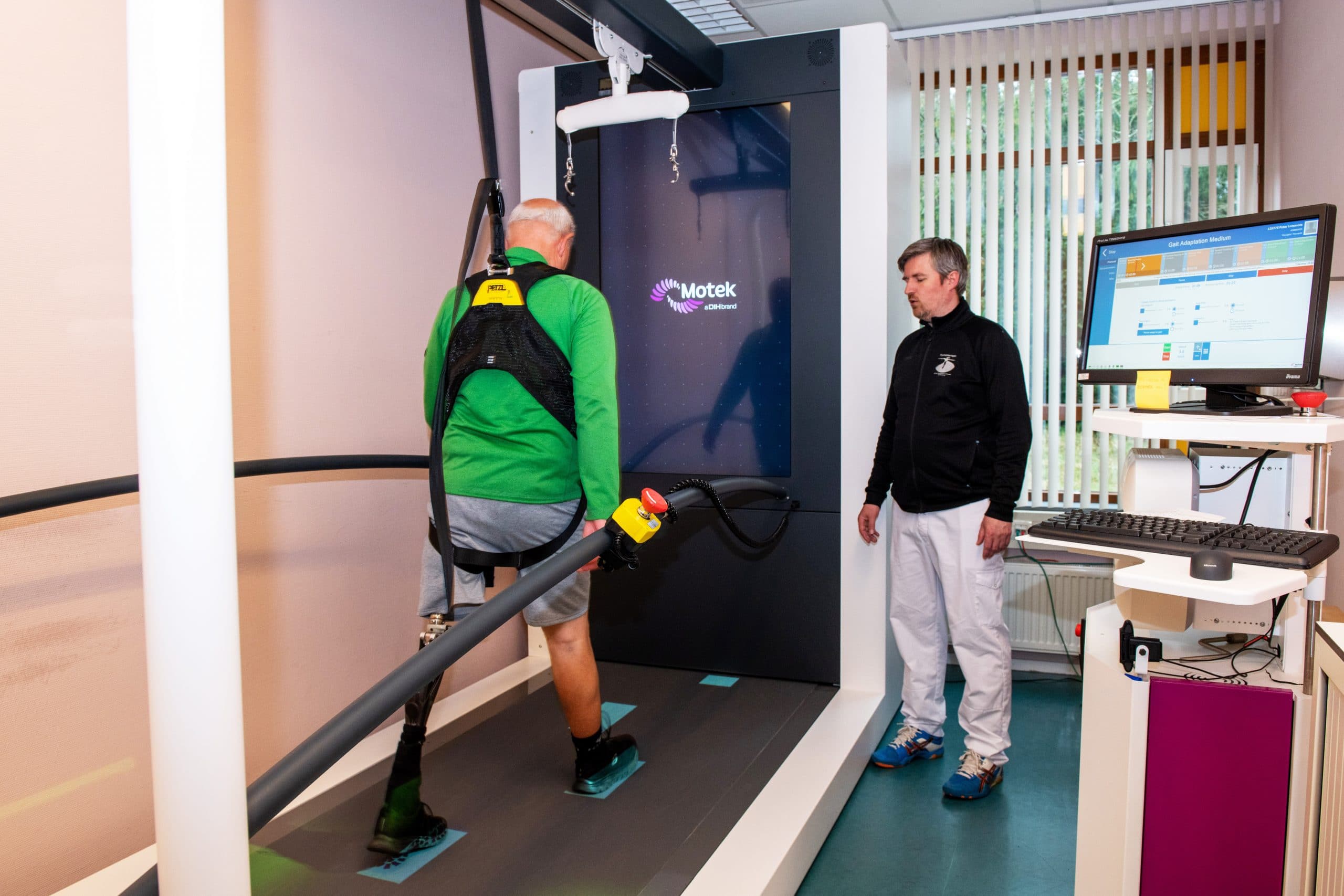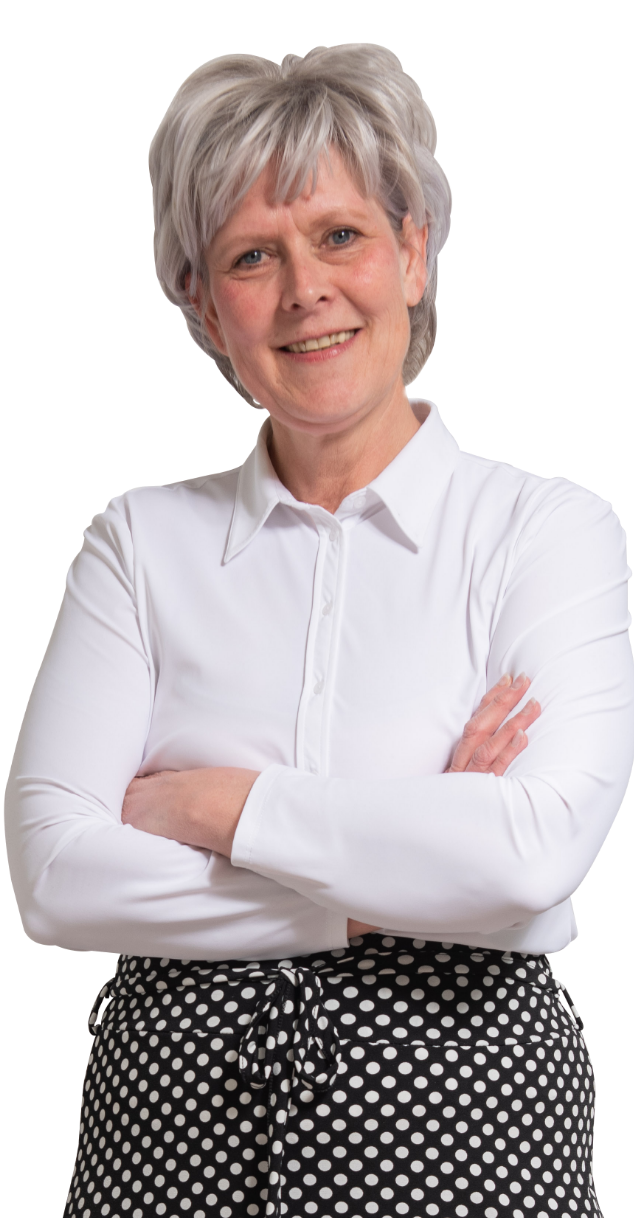
Start of osseointegration (click) prosthesis rehabilitation
AOFE Clinics collaborates with the Aardenburg Military Rehabilitation Centre in Doorn. Rehabilitation to under or upper limb starts 3-6 weeks after surgery, depending on bone quality and ingrowth. You may be advised to start rehabilitation later than discussed with you prior to surgery. This health care will be coordinated with you individually. Please read more about the main content on our website.
Muscle pain a limiting factor for physical therapy
Muscle pain due to limb loss is a major limiting factor for progress in rehabilitation for an amputee. Especially in people with an osseointegration prosthesis in the upper leg, the gluteal and stump muscles are severely weakened after years of socket use. When walking with an osseointegration prosthesis, the stump muscles must be fit and strong to stabilise the leg prosthesis. This muscle building during rehabilitation may be accompanied by a lot of muscle pain. The rehabilitation team will guide you through this and, if necessary, prescribe painkillers or adjust the pace of rehabilitation. Muscle pain in the stump occurs particularly when crutches are phased out. Sometimes it is necessary to take a rehabilitation break when pain is a limiting factor for gait training without walking aids.
Leg prosthesis – alignment and adjustment
Leg prosthesis adjustment is an important aspect of rehabilitation and depends on the rehabilitation phase. AOFE Clinics works with the prosthesis maker at Aardenburg Military Rehabilitation Centre in Doorn.
Stoma care instructions
The experience expert of the AOFE Clinics osseointegration team will go through the instructions for stoma cleaning with you and give you tips for the materials and devices that you can use. The rehabilitation doctor is present at the rehabilitation session every week and can prescribe stoma products if necessary in case of stoma irritation.
Duration of rehabilitation
For Dutch patients, rehabilitation takes about six weeks for lower leg osseointegration (click) prosthesis and 12 weeks for an upper leg osseointegration (click) prosthesis. The rehabilitation doctor will discuss progression with you and the team in mid-term evaluations and tailor the rehabilitation content and duration to you. Non-Dutch patients will undergo four weeks of rehabilitation for lower leg osteointegration prosthesis and six weeks for upper leg osteointegration prosthesis. Additional prosthesis rehabilitation will be prescribed if required in the respective home country.
Upper leg osseointegration (click) prosthesis rehabilitation protocol (standard)
Week 1: Increasing prosthetic load.
- Leg prosthesis fitting and alignment including connector instructions.
- With the leg prosthesis constructive loading using a scale up to 100% of body weight.
- Exercises for hip mobility, strength, training, for trunk, buttock and stump muscles.
- Stoma care instructions and pain management instructions.
Weeks 2 and 3: Walking in the bridge.
- Standing and balance training
- Walking training: different walking patterns (sideways, backwards, stopping and turning).
Week 4 to 6: Walking training with crutches.
- Basic walking training with crutches in 3-point gait and 2-point gait.
- Climbing stairs.
- Walking training on uneven surfaces.
Week 7 to 11: advanced walking training (optional).
- Walking training without walking aids.
- Walking training with inclines, obstacles, and double tasks.
Upper leg osseointegration (click) prosthesis rehabilitation protocol (adapted). Indication for adapted protocol is on the advice of the surgeon
Week 1-6 : Increasing prosthetic load to a maximum of 50% of body weight.
- Leg prosthesis fitting and alignment including connector instructions.
- With the leg prosthesis constructive loading using a scale up to 50% of body weight.
- Standing and balance training.
- Walking in the bridge and walking with crutches in a 3-point gait.
- Exercises for hip mobility, strength training for trunk and stump muscles.
- Stoma care instructions and pain management instructions.
Week 7-9: Increasing leg prosthesis load to 100% of body weight.
- With the leg prosthesis constructive loading using a scale up to 100% of body weight.
- Standing and balance training.
- Walking in the bridge and walking with crutches in a 3-point gait.
- Walking training: different walking patterns (sideways, backwards, stopping, turning).
Week 10 to 12: Walking training with crutches.
- Basic walking training with crutches in 3-point gait and 2-point gait.
- Climbing stairs.
- Walking training.
- Walking training on uneven surfaces
Week 13-17: Advanced walking training.
- Walking training without aids.
- Walking training with inclines, obstacles, and double tasks.
Lower leg osseointegration (click) prosthesis rehabilitation protocol
Week 1: Build up leg prosthesis load.
- Leg prosthesis fitting and alignment including connector socket.
- Build up to 100% of body weight with leg prosthesis using scale.
- Exercises for hip mobility, strength training for torso, buttock and stump muscles.
- Stoma care instructions and pain management instructions.
Week 2: Walk in the bridge.
- Standing and balance training.
- Walking training: different walking patterns (sideways, backwards, stopping and turning).
Week 3: Walking training with crutches.
- Basic walking training with crutches in 3-point gait and 2-point gait.
- Walking stairs.
- Walking training on uneven surfaces.
Week 4: advanced walking training.
- Walking training without aids.
- Walking training with inclines, obstacles, and double tasks.
Why choose for AOFE?
At AOFE Clinics, the main focus of prosthesis rehabilitation after osseointegration is to restore the functional ability of individuals who have undergone this innovative medical procedure. Located within a state-of-the-art hospital, our comprehensive range of services is designed to meet the specific needs of each individual, ensuring a tailored and effective treatment plan. Our dedicated team, comprised of prosthetists, therapists, and medical professionals, works closely with patients to develop a holistic approach that encompasses not only physical rehabilitation but also addresses the broader aspects of their lives.
With an open and collaborative approach, our research-based rehabilitation programs are developed to provide both pre- and post-assessment data, allowing us to track progress and make real-time adjustments for optimal outcomes. The integration of advanced artificial limbs, such as knee and lower limb prosthetics, empowers patients to regain control over their movements, skipping the limitations once imposed by injury or disease. We recognize that rehabilitation is not solely a clinical process; it’s about rebuilding lives and forging a path towards an active and fulfilling future. Our services extend beyond the hospital walls, offering educational resources, family support, and community links to assist patients in transitioning back into everyday life. Through dedicated occupational therapists and performance-based exercises, individuals learn to navigate a new range of activities, from basic day-to-day tasks to specialized work-related functions.
Children are a special focus at AOFE Clinics, and our pediatric prosthetists work with young patients to ensure that their artificial limbs not only support physical development but also adapt to their evolving needs. Our commitment to accessibility and open communication means that families receive the guidance and resources they need to become an integral part of their child’s rehabilitation journey. As a international leader in prosthetics rehabilitation, AOFE Clinics continues to search for new avenues of improvement. Our ongoing research collaborations and data-driven approach enable us to refine our techniques and enhance patient outcomes. By addressing not only the medical and physical aspects but also the emotional and social issues related to limb loss, we strive to offer a comprehensive service that truly improves the quality of life for every individual we have the privilege to serve.
A clear focus for a better quality of life
At AOFE Clinics, our prosthesis rehabilitation program is designed to help amputees regain function and return to their careers and daily activities with confidence. Our dedicated team of therapists and prosthetists works closely with each patient, providing personalized care that combines exercise, education in prosthetic use, and general wellness strategies. Patients have easy access to our comprehensive services through the “skip to menu” feature on our site, which directs them to various resources, including detailed program descriptions and feedback portals. This feedback is invaluable as it helps us refine our methods and ensure that our approach in medicine and rehabilitation meets national standards and patient expectations.
We encourage our patients to regularly engage with their therapist during their rehabilitation journey, as ongoing communication is crucial for assessing progress and making necessary adjustments to their exercise and education regimen. The trauma-led programme at our practice specializes in orthotics and spinal care for amputees, with many patients referred through our robust referral system. At AOFE Clinics, we are committed to working alongside our patients for as long as needed to help them achieve the best possible outcomes and lead a fulfilling life post-amputation. For more information on our prosthesis rehabilitation services, contact us via our site’s forms or get access to useful documents.
